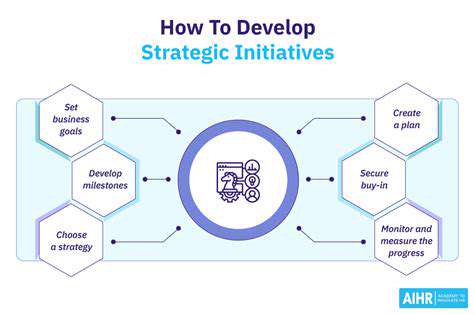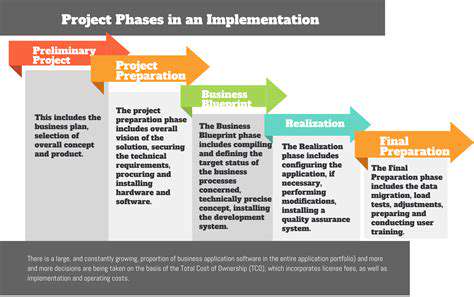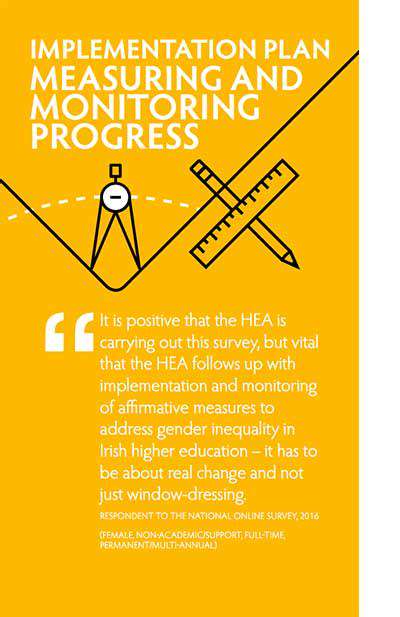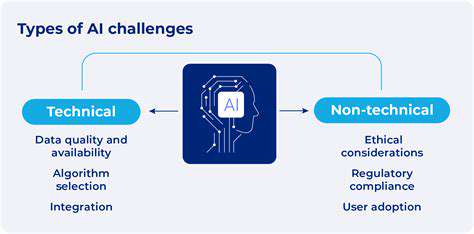Assessing Your Current State and Identifying Gaps
Understanding Your Current Digital Landscape
A crucial first step in crafting a successful digital transformation roadmap is a thorough assessment of your current digital infrastructure and processes. This involves examining existing systems, applications, data management practices, and the overall digital capabilities of your organization. Identifying strengths and weaknesses is paramount to understanding where you stand and how far you need to go. This includes evaluating the efficiency of existing workflows, the level of digital literacy among employees, and the responsiveness of your organization to changing market demands. Analyzing the current digital environment provides a critical baseline for future planning and helps pinpoint areas needing improvement.
Identifying Key Business Objectives and Goals
Before diving into specific digital transformation initiatives, clearly define your organization's strategic objectives and goals. What are you hoping to achieve through this transformation? Increased efficiency, enhanced customer experience, new revenue streams, or cost reduction? Articulating these aims in measurable terms allows you to align your digital transformation efforts with your overall business strategy. These objectives should be specific, measurable, achievable, relevant, and time-bound (SMART) to ensure focus and progress tracking.
This requires a deep understanding of your business's unique context, industry trends, and competitive landscape. Consider what sets your organization apart and how digital transformation can leverage these strengths.
Assessing Existing Resources and Capabilities
A critical component of assessing your current state involves evaluating your available resources, both human and technological. Do you have the necessary skills and expertise within your workforce to execute a digital transformation project? Do you have the financial resources to invest in new technologies and training? This step ensures a realistic understanding of your capabilities and limitations, preventing unrealistic expectations and ensuring that your digital transformation plan is achievable within your constraints.
Analyzing Customer Needs and Market Trends
Understanding your customer base and the ever-evolving market is crucial for a successful digital transformation. Analyze customer preferences, expectations, and pain points to identify opportunities for improving the customer journey. Are your current digital channels effectively engaging customers? Are there emerging technologies or trends in your industry that could provide new opportunities for value creation? Identifying these patterns and trends allows you to tailor your digital transformation strategy to meet the evolving needs of your customers and the competitive landscape.
Evaluating Existing Systems and Technologies
Thoroughly evaluate the functionality and effectiveness of your existing systems and technologies. Are they outdated or inefficient? Are they capable of supporting future growth and business objectives? This evaluation should consider not only the technical aspects but also the integration and interoperability of different systems. Are there potential bottlenecks or redundancies in your current technological architecture? Understanding these limitations will help you make informed decisions about system upgrades, replacements, or integrations.
Pinpointing Digital Transformation Gaps
Once you have a comprehensive understanding of your current state, identify the critical gaps between your current capabilities and the desired future state. What are the key areas where you need to improve or invest in new technologies and skills? This step is essential in prioritizing initiatives and allocating resources effectively. Mapping out these gaps creates a clear roadmap for your digital transformation journey and helps you focus on the most impactful areas for improvement.
Developing a Baseline for Measurement
Establishing a baseline for key performance indicators (KPIs) is essential to track the progress of your digital transformation initiatives. Define measurable metrics that reflect your objectives and goals, such as improved customer satisfaction scores, increased efficiency in workflows, or enhanced operational agility. Regular monitoring and evaluation of these KPIs will provide valuable insights into the effectiveness of your transformation efforts and allow for course correction as needed. This crucial step is often overlooked but is vital for demonstrating ROI and making data-driven decisions throughout the process.

Building a Phased Implementation Plan

Phased Approach for Optimal Results
A phased implementation strategy is crucial for successfully integrating new systems or processes. This approach allows for a more controlled and manageable rollout, reducing the risk of overwhelming resources and minimizing potential disruptions. By breaking down the implementation into smaller, sequential phases, organizations can better assess the impact of each step, identify and address any challenges as they arise, and fine-tune the system according to real-world feedback. This meticulous approach is vital for long-term success and ensures a smoother transition for all stakeholders.
Careful planning and meticulous execution are paramount in each phase. This allows for adjustments to be made based on the progress, and allows for the identification of areas where the process can be optimized. Thorough documentation and communication throughout each phase are also critical for maintaining transparency and fostering collaboration among all teams involved.
Defining Clear Milestones and Metrics
Establishing clear milestones and metrics is essential for tracking progress and ensuring accountability throughout the implementation. Each phase should have specific, measurable, achievable, relevant, and time-bound (SMART) goals, enabling teams to effectively measure their performance against the set objectives. This method allows for constant monitoring and evaluation, promoting continuous improvement. These milestones should be documented and communicated effectively to all stakeholders to ensure alignment and a shared understanding of progress.
These metrics will provide valuable insights into the effectiveness of the implementation process. They will allow for real-time adjustments to be made, and will also highlight areas that may require more attention or resources. Regular review meetings are essential for discussing the data and making necessary adjustments to the plan.
Resource Allocation and Management
Effective resource allocation is critical for a successful phased implementation. Careful planning and budgeting are essential to ensure that the necessary personnel, tools, and technologies are available at each stage. This process requires meticulous planning and efficient management of resources. It also ensures that the project stays on track and within budget.
Communication and Stakeholder Engagement
Open and transparent communication is paramount throughout the entire implementation process. Keeping stakeholders informed about progress, challenges, and potential impacts is essential for maintaining buy-in and minimizing resistance. This communication strategy also helps foster a collaborative environment, promoting a shared understanding of the project's goals and objectives.
Regular updates, progress reports, and feedback sessions are vital for maintaining stakeholder engagement. Addressing concerns promptly and proactively is crucial for ensuring that everyone feels heard and valued. This approach strengthens the overall project support and reduces the likelihood of unexpected delays or setbacks.
Measuring and Monitoring Progress and Adapting Your Plan

Defining Measurable Outcomes
Establishing clear, measurable outcomes is crucial for tracking progress effectively. These outcomes must be specific, quantifiable, achievable, relevant, and time-bound (SMART). Without well-defined metrics, it's difficult to determine if efforts are yielding desired results. Clearly outlining what constitutes success is paramount to evaluating progress accurately.
For instance, instead of a vague goal like improve customer satisfaction, a SMART outcome might be increase customer satisfaction scores by 15% within the next quarter, measured by the quarterly customer satisfaction survey. This specific and quantifiable goal provides a concrete benchmark for progress monitoring.
Choosing the Right Metrics
Selecting appropriate metrics is essential for accurately reflecting progress. These metrics should directly align with the defined outcomes and provide a clear picture of the impact of implemented strategies. Metrics should be relevant to the specific objectives and not overly complex or difficult to track.
Consider the various data points available, such as sales figures, customer feedback, website traffic, or employee engagement scores. The selection of the most suitable metrics will depend on the nature of the project or initiative.
Establishing a Baseline
Before implementing any changes or strategies, it's crucial to establish a baseline. This baseline provides a reference point for measuring progress and evaluating the effectiveness of interventions. Understanding the current state allows for a more accurate assessment of improvements and the identification of areas requiring further attention. Collecting data on key metrics before any interventions occur allows for a thorough comparison of before and after measurements.
Developing a Monitoring Plan
A well-structured monitoring plan is vital for tracking progress consistently. This plan should outline the specific metrics to be tracked, the frequency of data collection, the methods for data analysis, and the responsibilities of individuals involved in the process. Establishing a clear plan ensures that progress is monitored diligently and that any necessary adjustments can be made promptly.
Regular reviews and reporting are also key components of an effective monitoring plan. These reviews provide an opportunity to assess the collected data, identify trends, and make data-driven decisions.
Utilizing Data Visualization Tools
Data visualization tools offer valuable insights into progress trends and patterns. These tools enable the presentation of complex data in an easily understandable format, facilitating the identification of key insights and patterns. Visual representations of data can provide a compelling narrative about progress and can be easily disseminated to stakeholders.
Implementing Feedback Mechanisms
Integrating feedback mechanisms into the monitoring process is crucial for continuous improvement. This allows for the collection of insights from stakeholders, employees, and customers. Regular feedback loops facilitate a deeper understanding of the impact of implemented strategies and help guide adjustments and refinements as needed.
By actively seeking feedback, organizations can create a more responsive and adaptable approach to progress measurement and monitoring. This iterative approach enables the optimization of strategies and ensures that initiatives remain aligned with organizational goals.
Regular Reporting and Communication
Regular reporting and communication are essential for keeping stakeholders informed about progress. These reports should clearly communicate the key metrics, trends, and insights derived from the data. Effective communication fosters transparency and promotes shared understanding of the progress being made. This transparency helps to build confidence and maintain momentum.
Regular updates and presentations to relevant stakeholders ensure that everyone is on the same page regarding the project's status and any necessary adjustments.











